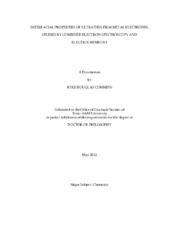| dc.description.abstract | A pair of studies investigating the deposition and surface chemical properties of ultrathin metal films were pursued: (i) Pt-Co alloys on Mo(110); and (ii) Pd on Pt(111). Experimental measurement was based on a combination of electron spectroscopy (low energy ion scattering spectroscopy, X-ray photoelectron spectroscopy, Auger electron spectroscopy, and low energy electron diffraction) and electrochemistry (voltage efficiency, voltammetry, and coulometry).
Mixed-metal preparation of Pt-Co films by thermal vapor deposition (TVD) resulted in a thin-film binary alloy. Careful analysis revealed a substantial divergence between the composition at the interface and that in the interior. This outcome was observed for all compositions and allowed for the construction of a ?surface phase diagram?. The proclivities of the alloys of pre-selected compositions towards enhanced catalysis of the oxygen-reduction reaction were assessed in terms of their voltage efficiencies, as manifested by the open-circuit potential (OCP) in O2-saturated dilute sulfuric acid electrolyte. The particular alloy surface, Pt3Co (XPt=3,XCo=1), whether from the thin film or a bulk single crystal, exhibited the highest OCP, a significant improvement over pure Pt but still appreciably lower than the thermodynamic limit. Under test conditions, the degradation of thusly-prepared films was primarily due to Co corrosion.
Ultrathin Pd films on well-defined Pt(111) surfaces, with coverages from 0.5 to 8 monolayers (ML), were prepared by surface-limited redox replacement reaction (galvanic exchange) of underpotentially deposited Cu. Spectroscopic data revealed that films prepared in this manner are elementally pure, pseudomorphic to the substrate, and stable, independent of the surface coverage (?) of palladium. Analysis of the voltammetric profiles in the hydrogen evolution region revealed unique properties of hydrogen adsorption unseen in bulk electrodes. Notably, at 1 ML coverage, a step-free film was produced that did not exhibit hydrogen absorption. At higher coverages, digital (layer-by-layer) deposition gave way to 3D islands in a Stranski- Krastanov growth mode; under these conditions, onset of bulk-like behavior was observed. This method makes possible the synthesis of well-ordered noble-metal films in the absence of high-temperature treatment | en |


